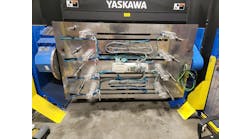With the proliferation of collaborative robots (cobots) during this seemingly endless pandemic, the focus of automation is very squarely in the realm of the interaction between people and machines.
Cobots are designed to be deployed on a production line where humans interact with them as if they were other humans. The use of just one cobot can make it possible to provide physical separation between workers on the line by putting the cobot between the work positions.
A by-product of the coronavirus pandemic has meant that some people choose to stay home rather than expose themselves to risk of infection. The loss of workforce has made the move to automation even more important, and the relatively low cost of cobots puts them at the forefront of automation plans.
The challenge of automation has always been to keep people safe while trying to produce more product in the same footprint. The faster a machine runs, the more physical space is required to guarantee that, if something goes wrong, the machine has enough time to come to a complete and safe stop before potentially making contact with humans or other machines around it. Traditionally, this would involve a physical cage around the piece of automation. This cage could take the form of a frame with either polycarbonate or expanded steel (fence) panels.
Made to physically defend a person from getting too close, these types of guarding systems also take up a lot of real estate. For this reason, they are not well-suited to a cobot application where we don’t want the new automated device taking up any more space than the human it is replacing.
The technology required to respond to this need for an ever tighter operating envelope has advanced dramatically, especially over the past two or three years. While we will delve into that momentarily, it is important to note that the robot manufacturers, in addition to coming up with new ways to sense the presence of people in proximity to the robot, have had to come up with ways to safely limit the range of operation to be inside the normal operating range of the robot.
As one can imagine, it’s not enough to just add software limits that are inside the physical (hard) limits of the various axes. The operating confines must absolutely prevent the robot from getting outside the working envelope and must do it in an intrinsically safe manner.
The lengths to which robot manufacturers have gone to guarantee the safety of those working in close proximity to robots is extensive. Both hardware and software has been developed to address these important criteria and the Robotic Industries Association (RIA), founded in 1974, works to ensure that all members conform to guidelines designed to keep the safety of personnel at the forefront of the manufacturing process.
Perhaps the best way to examine the need to interact with collaborative robots is to provide an example. In my own consumer-packaged-goods (CPG) manufacturing facility, we have recently started to employ cobots to automatically palletize cases of product.
For us, this is low-hanging fruit and, by the very nature of the operation, has the least risk involved as the palletizing or unitizing of product is at the very end of the production line. The heavy traffic areas in our production areas tend to be closer to the pouch-making and cartoning operations further up the line.
After the case is packed, there is a tape or glue machine and then coding equipment. This provides an automatic gap between the folks packing the cases and the folks that put the cases on a pallet.
To apply a cobot to palletizing, we added some roller conveyor to convey the finished cases to the infeed of the robot palletizer. The robot picks up one or more cases, depending on the weight of the product and the pack pattern; then it places the cases on one of two palletizing positions.
When one pallet stack is complete, the robot automatically starts placing cases on the opposition pallet position, and an operator comes by with a hand truck to remove the full pallet and replace it with an empty pallet. The time required to interact with the palletizer is minimal, allowing that operator to perform other tasks on the line or even on an adjacent line.
For the most part, the interaction between robot and human is minimal, but there are times where the human needs to be within range of the robot. The sensing of that human and how the robot reacts to that presence is key to the use of cobots.
In general, the need to have a safe operating envelope but not use hard guarding is taken up with the implementation of area scanners. These devices utilize a laser sensor that is passed back and forth over an arc of view in a two-dimensional scan that looks for objects that pass into the area of interest.
Area scanners can be trained to ignore fixed objects in the pre-defined scan path and look only for objects, such as a person, that wander into the protected area. One or more scanners may be used in tandem to broaden the area of protection.
Area scanners, like any other safety device, provide an input to a safety relay and can trigger a variety of responses, depending on the severity of the incursion. For example, if a person enters the far reaches of the protected area, the robot will slow down it’s movements but doesn’t need to stop.
However, if the person penetrates further into the area, to the point where the person might come into contact with the robot or the product on the robot, then the robot may either further reduce speed or suspend operation altogether. The implied reason for the speed reduction is the robot will travel less distance to come to a complete stop if it isn’t travelling fast to start with.
Just imagine that same scenario if you are driving down the interstate at 70 miles per hour and have to stop versus driving 10 miles per hour in your driveway and having to stop.
For the situation where the person gets into even closer proximity to the cobot, a number of other technologies come into play. While travelling slower, the cobot still has motive force, and coming into contact with a person has to cause an immediate stop and de-energizing of the robot to prevent further motion.
One technology in use is a simple outer shield device, such as a plastic guard, that will trip a proximity switch if the shield gets displaced. The shield is often held in place by light-duty magnets that will release the shield with minimal pressure.
Since the shield isn’t the actual robot arm or the end-of-arm tool, it doesn’t present an immediate danger to the person in the envelope and acts as a pre-warning (for lack of a better term) to cause the robot to cease operation before any contact is made with the working parts of the robot.
Another interesting technology employs the properties of conductive paint to turn the surface of the robot arm, and other components, into a sensor. Connected to appropriate electronics, the paint acts just like a pushbutton or other input device to cause the robot to respond accordingly.
The technology has been around for a while—more than five years, in fact—but this unique application to a robot truly makes it collaborative. Imagine, if you will, working alongside another person on a production line. While every human tends to have a comfort space around them, sometimes that space is diminished while working close to others. The human response to bumping into another object or person is to recoil from that interaction.
The clever engineers who have applied conductive coatings to a robot have added some of that behavior to the robot. In the most simple of cases, physically contacting the skin of the robot will cause the robot to immediately stop the robot, trip the safety circuit, thereby de-energizing the robot motion controllers, and generate an alarm that requires operator intervention to clear before resuming operation.
In more complex cases, the engineers have caused the robot to actually pull back, in a minute motion, from the source of contact. Compare that to two humans who might accidentally touch. The instinctive reaction is to pull back from that source of contact.
Presence sensing has become an ever more important tool in the automation industry. As we trend toward devices that mimic human function, it becomes increasingly important to develop technologies that resemble the human experience.
Just as powered flight mimicked the features and behaviors of birds, automation is really about duplicating the actions of humans. As cobots become more and more sophisticated, the need to create ever-decreasing work envelopes will be a natural progression, so expect to see even more innovation in the realm of presence sensing.






